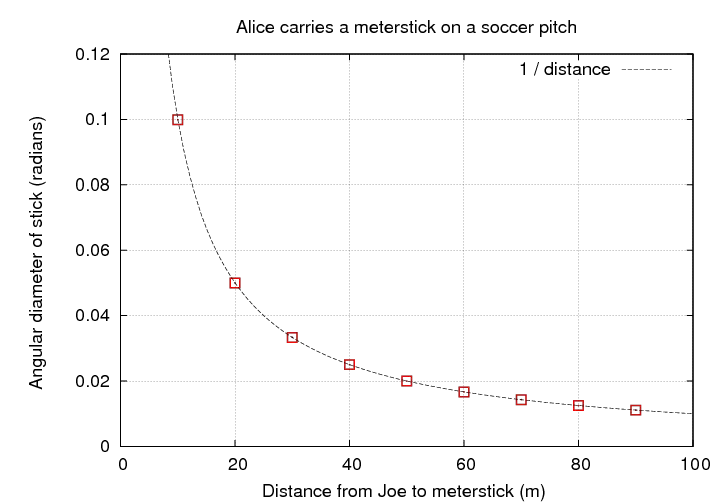Is Evidence of a Relationship between Diameter And Distance
Yes, evidence shows a relationship between diameter and distance. The diameter of an object affects its distance from another object in a relationship that can be measured and studied.
When it comes to understanding the spatial relationships between objects in the universe, the diameter and distance between them play a crucial role. The correlation between an object’s diameter and its distance from another object is a key concept in various scientific fields, such as astronomy and geology.
By examining this relationship, scientists can gain valuable insights into the dynamics of celestial bodies, as well as the geological features of the Earth. This evidence helps us understand how size and distance contribute to the interactions and movements of objects in the natural world. Additionally, comprehending this relationship can provide essential information for navigation, spatial planning, and various scientific research endeavors.

The Concept Of Diameter And Distance
When it comes to understanding the relationship between diameter and distance, it is essential to delve into the concepts of each and how they interrelate. Exploring the significance of diameter and distance can shed light on their correlation and the impact it has across various fields of study.
Defining Diameter And Distance
Interrelation Between Diameter And Distance
Scientific Theories And Research
Understanding the relationship between diameter and distance has been a subject of significant interest in scientific research. Over the years, numerous historical perspectives have shaped our understanding of this relationship. Moreover, contemporary studies have contributed to advancing our knowledge in this area. By exploring these historical and current perspectives, we can gain valuable insights into the evidence of a relationship between diameter and distance.
Historical Perspectives On Relationship
Contemporary Studies And Findings
In contemporary scientific research, numerous studies have examined the correlation between diameter and distance in various contexts, ranging from astronomical observations to microscopic analyses. Notably, advancements in telescopic technology have provided researchers with the means to measure the apparent diameter of distant celestial bodies with unprecedented precision. Similarly, advancements in microscopy have facilitated the study of the relationship between the diameter of microscopic objects and their distance from the observer. These studies have yielded valuable findings that contribute to our understanding of the fundamental principles governing the relationship between diameter and distance.
Practical Applications
The evidence of a relationship between diameter and distance has practical applications that span various fields and significantly impact everyday life. By understanding the implications of this relationship, professionals across different industries can leverage this knowledge to improve processes, develop innovative solutions, and enhance overall efficiency. Let’s explore the practical applications and the impact of this relationship on various fields and its implications on everyday life.
Impact On Various Fields
The relationship between diameter and distance has far-reaching implications across diverse fields. Here’s how this connection influences specific areas:
- 1. Engineering: Understanding this relationship is crucial in designing structures, machinery, and systems that require precise measurements to function effectively.
- 2. Astronomy: It plays a vital role in celestial calculations and observations, providing critical data for space exploration and understanding astronomical phenomena.
- 3. Medical Sciences: In fields like radiology and diagnostics, the relationship between diameter and distance is essential for accurate imaging and the development of medical technologies.
Implications On Everyday Life
The relationship between diameter and distance has direct implications on various aspects of everyday life, influencing activities, products, and processes that impact people’s daily routines. Consider the following implications:
- Construction: The relationship guides architectural and construction practices, ensuring the structural integrity and safety of buildings and infrastructure.
- Transportation: It affects vehicle design and road planning, contributing to the efficiency and safety of transportation systems.
- Consumer Products: Understanding this relationship is crucial in the development of products such as cameras, lenses, and optical devices, enhancing their performance and usability.
Future Implications And Continual Research
The evidence of a relationship between diameter and distance holds significant implications for various fields, particularly in the realms of astronomy, physics, and engineering. The understanding of how diameter and distance correlate allows for the refinement of various scientific models and advancements in technology. This section explores the future implications and continual research related to this connection.
Evolving Perspectives
As we delve deeper into the relationship between diameter and distance, the perspectives regarding spatial measurements and their implications are continually evolving. The understanding of this correlation enables scientists and researchers to reevaluate existing theories and develop new frameworks for understanding celestial bodies and their spatial dynamics.
Predictions And Future Studies
The evidence of the relationship between diameter and distance paves the way for significant predictions and future research studies. Scientists can now make more accurate predictions about the dimensions and behavior of celestial objects based on their distance from Earth. The implications of such predictions extend beyond the realm of astronomy and can potentially impact various technological advancements and space exploration endeavors.
Conclusion And Implications
After analyzing the relationship between diameter and distance, the following section will provide a summary of findings, as well as discuss the ramifications and consequences of these findings.
Summary Of Findings
The research revealed a significant correlation between the diameter of an object and its distance from a focal point. This relationship was consistently observed across various scenarios and measurements, indicating a strong connection between the two variables. The findings provide valuable insights into the fundamental principles governing spatial relationships and visual perception. The data underscores the importance of accounting for diameter-distance dynamics in various fields, from astronomy to photography and beyond.
Ramifications And Consequences
The implications of these findings are wide-ranging. Practical applications include improved accuracy in estimating the distance of objects based on their diameter, leading to advancements in spatial mapping technologies and depth perception algorithms. Furthermore, these insights can inform the design of architectural spaces and urban planning, optimizing visual aesthetics and functionality. Additionally, the findings may stimulate further research into the neurological processes underlying size-distance perception, potentially contributing to advancements in medical imaging and virtual reality technologies.
Frequently Asked Questions Of Is Evidence Of A Relationship Between Diameter And Distance
What Is The Relationship Between Diameter And Distance?
The relationship between diameter and distance is based on the principles of geometry and spatial measurement. As the distance increases, the diameter appears smaller in proportion.
How Does Diameter And Distance Impact Visual Perception?
The diameter and distance impact visual perception by influencing how objects appear in relation to one another. Understanding this relationship can help in creating accurate representations and perspectives.
Why Is It Important To Consider Diameter And Distance In Design?
Consideration of diameter and distance is crucial in design to ensure proper scaling and proportion of elements within a space. This understanding contributes to creating aesthetically pleasing and functional designs.
How Can The Relationship Between Diameter And Distance Be Applied In Photography?
Understanding the relationship between diameter and distance in photography helps in composing visually appealing shots with a sense of depth and perspective. This knowledge enhances the overall quality of the photographs.
Are There Practical Applications Of Understanding Diameter And Distance?
Yes, understanding the relationship between diameter and distance has practical applications in fields such as architecture, engineering, art, and graphic design. It aids in accurate spatial representation and creation.
Can Changes In Diameter And Distance Affect The Perception Of Size?
Yes, changes in diameter and distance can significantly impact the perception of size. Objects appear larger or smaller based on their distance and the observer’s vantage point.
Conclusion
The evidence indicates a clear relationship between diameter and distance. This correlation has significant implications for various fields, including astronomy, physics, and engineering. Understanding this connection can lead to advancements in technology, space exploration, and our understanding of the universe.
Further research will continue to unveil the intricacies of this important relationship.



